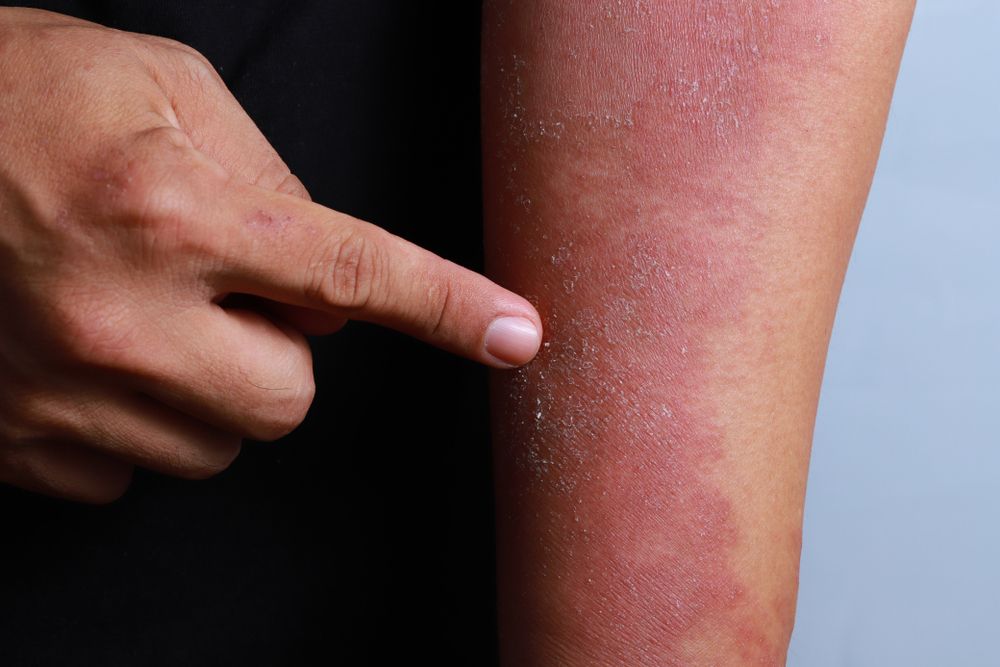- Acne
- Actinic Keratosis
- Aesthetics
- Alopecia
- Atopic Dermatitis
- Buy-and-Bill
- COVID-19
- Case-Based Roundtable
- Chronic Hand Eczema
- Chronic Spontaneous Urticaria
- Drug Watch
- Eczema
- General Dermatology
- Hidradenitis Suppurativa
- Melasma
- NP and PA
- Pediatric Dermatology
- Pigmentary Disorders
- Practice Management
- Precision Medicine and Biologics
- Prurigo Nodularis
- Psoriasis
- Psoriatic Arthritis
- Rare Disease
- Rosacea
- Skin Cancer
- Vitiligo
- Wound Care
Article
Diagnosing adult-onset atopic dermatitis
Author(s):
Twenty-five percent of adults with atopic dermatitis report the disease started in adulthood. Yet, diagnosing adult-onset atopic dermatitis can challenge even expert clinicians. Here's what you need to know.
While there are no diagnostic criteria specifically for adult-onset atopic dermatitis, H-R criteria for atopic dermatitis is the gold standard for diagnosing atopic dermatitis and helps diagnose adult-onset disease, says Dr. Silverberg. (©TYLim/Shutterstock.com)

Dr. Silverberg

To better diagnose, treat and manage adult-onset atopic dermatitis, dermatologists should know important differences between the disease when it starts in adulthood, versus in childhood, according to a Grand Rounds Review on adult-onset atopic dermatitis published January 2019 in the Journal of Allergy and Clinical Immunology: In Practice.
Twenty-five percent of adults with atopic dermatitis report the disease started in adulthood. Yet, diagnosing adult-onset atopic dermatitis can challenge even expert clinicians because these patients may present with different lesional morphology and distribution than children with atopic dermatitis. And adult-onset atopic dermatitis has a much broader differential diagnosis of eczematous disorders than child-onset disease, according to the paper.
Like childhood atopic dermatitis, adult-onset atopic dermatitis patients often have a chronic, relapsing or persistent itchy red rash, according to the article’s author Jonathan Silverberg, M.D., Ph.D., M.P.H., director of the Northwestern Medicine Eczema Center and Contact Dermatitis Clinic, Northwestern Memorial Hospital, Chicago. However, studies found some clinical differences including that adult-onset atopic dermatitis patients tend to have lower rates of atopic disease in their personal and family history. Adults might also have lower rates of conjunctivitis, facial dermatitis and other common clinical findings among children with the disease.
The physical examination and history taking are important in these patients, according to Dr. Silverberg. Dermatologists should look for patches, papules and plaques that are ill-demarcated and pink to red in lighter skin types or violaceous to brown on darker skin. The lesions blanch with pressure and often occur in a symmetric distribution, according to the paper.
While there are no diagnostic criteria specifically for adult-onset atopic dermatitis, H-R criteria for atopic dermatitis is the gold standard for diagnosing atopic dermatitis and helps diagnose adult-onset disease, says Dr. Silverberg.
“Sometimes, the least used test for ruling out other skin conditions is a comprehensive history and physical exam. Dermatologists often have very busy clinical practices with short encounters that may not afford sufficient time to evaluate all the different criterion encompassed in the H-R criteria. Atopic dermatitis is a clinical diagnosis. Biopsies and blood tests are not required to make the diagnosis,” Dr. Silverberg says. “H-R criteria are a more standardized criteria for diagnosing atopic dermatitis. I personally use H-R criteria in routine clinical practice and find it helpful in many challenging cases. I recommend that clinicians use H-R or other formal criteria to improve the diagnosis of atopic dermatitis.”
The next step is to rule out entities in the differential diagnosis. A punch biopsy with standard hematoxylin and cosin staining can help to exclude psoriasis, cutaneous lupus or mycosis fungoides/CTCL. Microscopic evaluation of a skin scraping can help rule out scabies or fungal infections. And epicutaneous patch testing, recommended in a recent consensus guideline for consideration in all atopic dermatitis patients, can help detect allergic contact dermatitis, which often occurs along with and mimics atopic dermatitis.
Other differential diagnoses of adult-onset atopic dermatitis include eczematous drug eruption, dermatophyte infection, autoimmune blistering diseases, Churg-Strauss syndrome; paraneoplastic dermatitis, Wiskott-Aldrich syndrome or other immunodeficiency syndromes, according to the paper.
Those that Dr. Silverberg says he most often sees in practice that are most likely to mimic adult-onset atopic dermatitis are allergic contact dermatitis, psoriasis and cutaneous T cell lymphoma.
Managing adult-onset atopic dermatitis is much like managing childhood atopic dermatitis. It, too, uses a step-care approach, according to the paper.
Little is known about the prognosis of adult-onset atopic dermatitis, according to Dr. Silverberg. But it’s important for dermatologists to recognize that atopic dermatitis in adults and children can have major impacts on health and quality of life and has been associated with many medical and mental health comorbidities. These tend to get better when the atopic dermatitis symptoms improve, he says.
Disclosures:
Dr. Silverberg served as a consultant and/or advisory board member for Abbvie, Asana, Dermavant, Dermira, Eli Lilly, Galderma, GlaxoSmithKline, Glenmark, Kiniksa, Leo, Menlo, Pfizer, Regeneron-Sanofi, Realm. He has received honoraria and been a speaker for Regeneron-Sanofi. He also has received research grants from GlaxoSmithKline and Galderma.
Newsletter
Like what you’re reading? Subscribe to Dermatology Times for weekly updates on therapies, innovations, and real-world practice tips.











